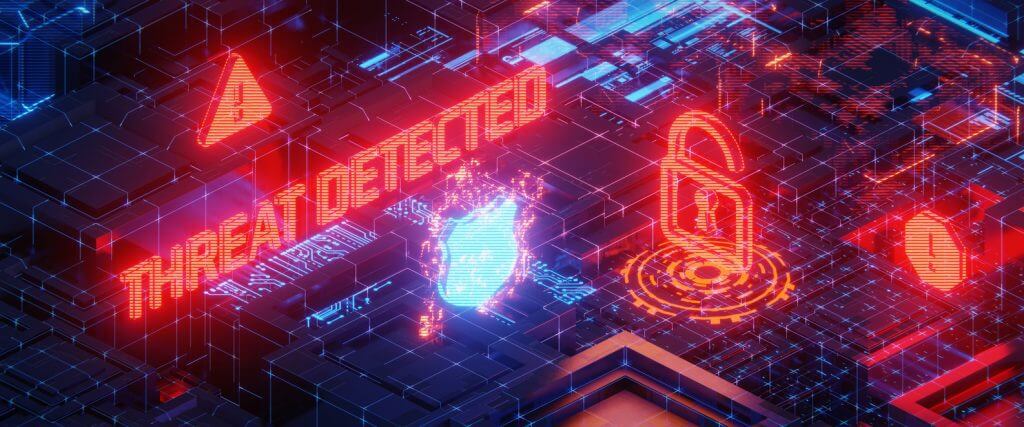Inhalt
In today’s post, our authors highlight the role of Network Detection & Response (NDR) in enterprise cyber defense strategy.
Also learn how you can realize effective, sustainable and reliable threat detection through the interaction of NDR, EDR and SIEM.
What is Network Detection and Response (NDR)?
Network Detection and Response (NDR) is a network-based security approach that continuously monitors and analyzes an organization’s entire traffic based on static rules, machine learning and threat intelligence.
The solution includes all internal data traffic as well as external communication, thus taking into account sources such as client and server systems, network components, but also IOT sensors or OT devices. By systematically and automatically monitoring data traffic and network behavior, NDR solutions learn “normal behavior”. If patterns deviating from this learned behavior occur, such as suspicious access to systems or data exfiltrations, an alarm is triggered automatically by the NDR solution. These alerts should be collected centrally, for example in a security information and event management (SIEM) system, and correlated with other data, for example from an endpoint detection and response (EDR) solution.
With the help of the SIEM, the cyber defense analyst can centrally and efficiently analyze irregularities that occur and, if necessary, react to them in a targeted manner – both ideally supported by a SOAR system (Security Orchestration Automation and Response).
What are the 5 essential features of an NDR solution?
A Network Detection and Response (NDR) solution has a number of essential features that help detect and respond to network threats.
The 5 key features of NDR are:
- Network traffic monitoring: an NDR solution monitors and analyzes network traffic for potential threats. This can be done by using technologies such as intrusion detection systems (IDS) and intrusion prevention systems (IPS).
- Behavioral analysis: an NDR solution uses machine learning algorithms to analyze the behavioral pattern of network traffic and detect anomalies that may indicate a potential threat.
- Automatic response: an NDR solution can automatically respond to detected threats by, for example, disconnecting network connections or implementing rules in the firewall system.
- Integrity protection: An NDR solution can also ensure that the integrity of the network is maintained by monitoring changes to configurations and by monitoring unauthorized access to network resources.
- Reporting and forensics: An NDR solution provides the ability to generate detailed reports and forensics data that can help investigate security incidents and identify attackers.
The benefits of NDR in cyber defense
As discussed above, an NDR solution is a continuously learning system due to its Artificial Intelligence and Machine Learning features. The deep understanding of normal network behavior that it achieves leads to reliable and rapid identification of anomalies. In addition, NDR solutions enable the detection of attack patterns that would go undetected on endpoints. Continuous analysis also achieves signature-independent detection of previously unknown security threats. The result is an improved level of IT security – especially when existing SIEM, EDR or SOAR solutions are complemented by NDR. Even sophisticated cyber attacks can be identified and defended against at an early stage.
Take the example of a ransomware attack: here, the attackers already leave traces in the network data traffic long before they reach their actual target, e.g., the encryption of data. An indication of a ransomware attack could be, for example, requests and communications with targets outside the network, possibly at unusual working hours. Internal network traffic can also provide clues: are supposed employees suddenly accessing systems and applications they don’t usually use?
In addition, data exfiltration from the internal network can be another indicator of impending encryption, as ransomware groups often use the stolen data to further extort money from the affected company.
How does NDR work with Security Information and Event Management (SIEM)?
NDR and SIEM work together with the overarching goal of detecting, verifying and responding to threats by collecting and sharing information.
NDR collects and analyzes network information to identify attacks. Once an attack is identified, an NDR solution can automatically respond by isolating affected devices to prevent the spread of the attack and clean up affected areas. Further, an NDR solution makes all collected information available to the SIEM system.
The SIEM uses this information along with other events from various security devices and applications in real time. It correlates this data to detect potential threats and generate alerts.
Also, the information gathered by NDR can in turn be used by cyber defense analysts to adjust detection rules in the SIEM to better detect and defend against future attacks.
In summary, NDR supports the SIEM by, among other things:
- Capturing and analyzing connection data from network traffic
- Providing an immutable data source
- Optimizing complete, comprehensive reports
- Covering log gaps
- Log analysis as well as aggregation and detection of behavioral threats
How does Endpoint Detection & Response (EDR) complement an NDR solution?
The term EDR stands for endpoint-based detection and response. Thus, the focus of EDR solutions is on increasing the visibility of anomalies at the endpoint: protection takes place directly on endpoints, not at the network perimeter. Endpoints – any device connected to a network – are potential gateways for cyber threats. With Endpoint Protection & Response (EDR), endpoint activity is captured, logged and analyzed in real time.
EDR solutions are thus a valuable part of the cyber defense toolset, but their focus on endpoints means they are unable to monitor network traffic and activity that occurs outside the endpoint. This type of monitoring and analysis requires a Network Detection and Response (NDR) solution. As a result, the two technologies complement each other perfectly, correlating the information gathered to create a more detailed security picture and provide comprehensive detection and mitigation of attacks.
Why you should combine NDR, EDR and SIEM
SOC teams still rely heavily on endpoint detection and response (EDR) and security information and event management (SIEM) tools in their work. However, these tools cannot provide visibility into traffic and thus only provide a small, very limited slice of security-related activity. Only when supplemented with an NDR can cyberattacks be detected, analyzed, and targeted at an early stage. Only a combination of NDR, EDR and SIEM thus makes it possible to detect threats and attacks at the application level, network level and endpoint level and to react immediately.
Would you like to ensure effective threat detection for your company? We would be happy to advise you in a personal meeting – feel free to contact us online or by phone: +49 30 5557021 11!









